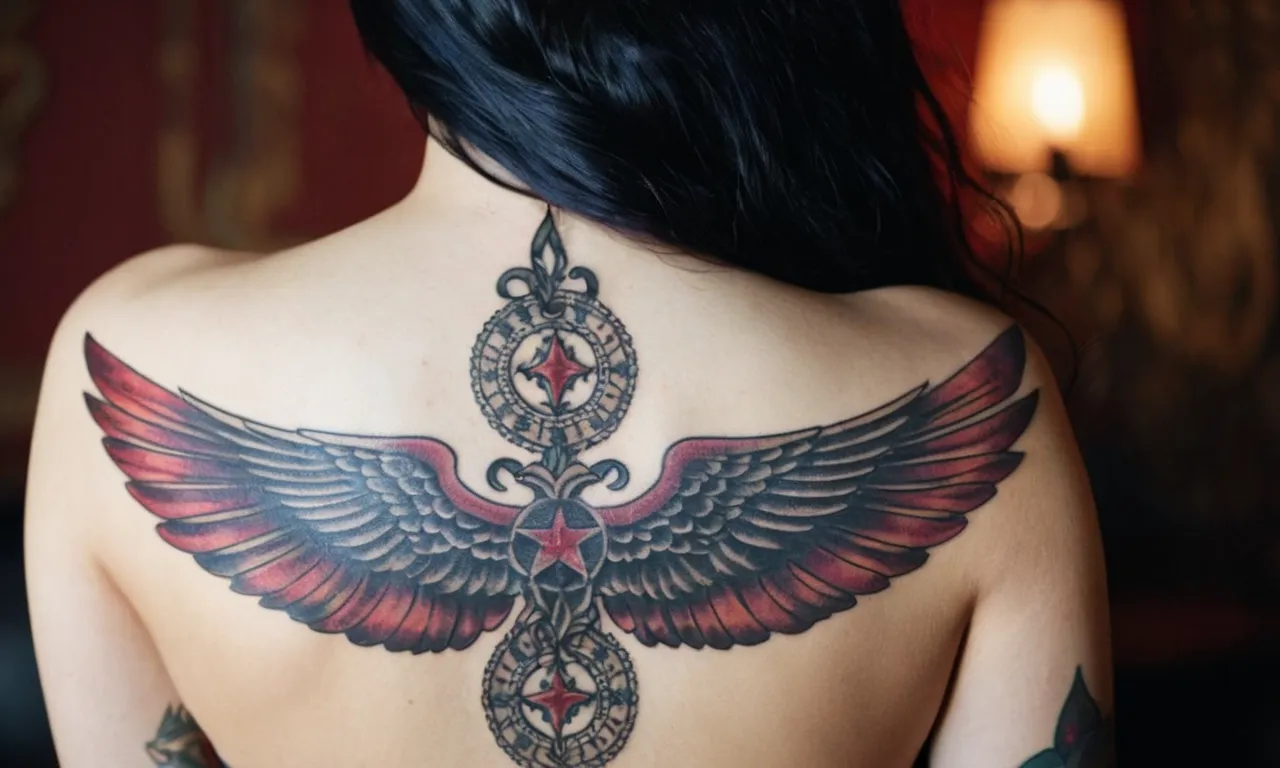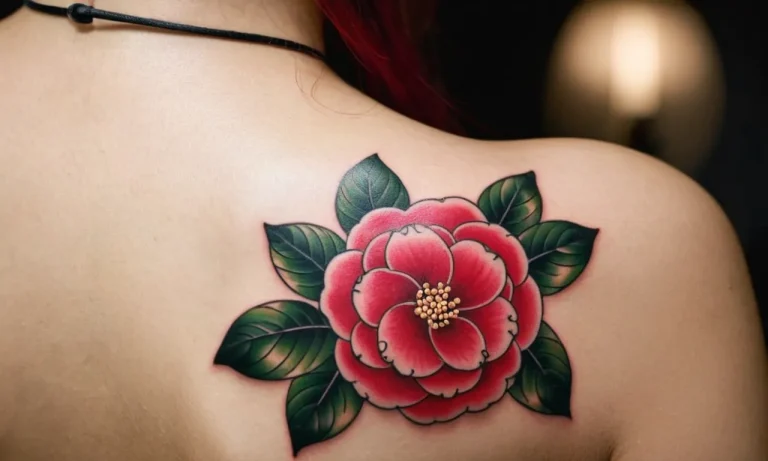Lilith Symbol Tattoo Meaning: Unveiling The Mysteries Of The Dark Feminine
In the realm of tattoo art, few symbols carry as much intrigue and mystique as the Lilith symbol. This ancient emblem, steeped in mythology and folklore, has captivated the imaginations of countless individuals seeking to embrace their inner strength and feminine power.
If you’re short on time, here’s a quick answer to your question: The Lilith symbol tattoo represents the dark, rebellious, and untamed aspects of the feminine divine. It is associated with the mythological figure of Lilith, Adam’s first wife in Jewish folklore, who refused to submit to him and was subsequently banished from the Garden of Eden.
In this comprehensive article, we will delve into the rich symbolism and cultural significance of the Lilith symbol tattoo. From its origins in ancient mythology to its modern interpretations, we will explore the various facets of this captivating design, providing you with a deep understanding of its meaning and significance.
The Origins of the Lilith Myth
The Babylonian Roots
The origins of the enigmatic figure of Lilith can be traced back to ancient Babylonian mythology, where she was depicted as a winged spirit or demon. According to scholars, the name “Lilith” is derived from the Sumerian word “Lil,” meaning “air” or “wind.”
This association with the elemental force of air lends an ethereal and elusive quality to her character. In Babylonian texts, Lilith is often portrayed as a fearsome creature who preys on pregnant women and newborn infants, reflecting the ancient fear of infant mortality.
Lilith in Jewish Folklore
Lilith’s journey through history takes a significant turn in Jewish folklore, where she is cast as Adam’s first wife, created from the same earth as him. According to the Alphabet of Ben Sira, an 8th-century midrashic text, Lilith refused to submit to Adam’s authority and fled the Garden of Eden after uttering the ineffable name of God.
This act of defiance and rebellion against patriarchal norms established Lilith as a symbol of female empowerment and autonomy.
In Jewish folklore, Lilith’s story intertwines with the realm of the supernatural. She is often depicted as a seductress who ensnares men in their dreams or as a vengeful spirit who steals infants from their cribs.
This duality of Lilith as both a powerful feminine force and a malevolent entity has captivated the imagination of scholars and storytellers alike. Sources like the Jewish Virtual Library provide a wealth of information on the various interpretations and traditions surrounding this enigmatic figure.
The Rebellious First Wife
Perhaps the most intriguing aspect of Lilith’s myth is her portrayal as the rebellious first wife of Adam. According to the Alphabet of Ben Sira, when Adam attempted to subdue Lilith and assert his dominance, she uttered the sacred name of God and flew away from the Garden of Eden.
This act of defiance against patriarchal authority has resonated with many as a symbol of female empowerment and resistance against oppression.
Lilith’s refusal to submit to Adam’s will has been interpreted as a rejection of traditional gender roles and a celebration of female autonomy. Her story challenges the notion of a woman’s subservience to her husband and encourages a more egalitarian perspective on relationships.
This aspect of Lilith’s myth has found particular resonance in modern feminist discourse, inspiring countless works of art, literature, and personal expression. 😍👏
As a symbol of the “dark feminine,” Lilith represents the aspects of womanhood that have historically been suppressed or feared – the fierce, independent, and sexually liberated. Her story serves as a reminder that embracing the fullness of one’s feminine power, even in the face of societal norms, can be a transformative and empowering journey.
The enduring legacy of the Lilith myth lies in its ability to challenge conventions and inspire individuals to embrace their authentic selves without apology.
The Symbolism of the Lilith Tattoo
The Lilith tattoo has emerged as a powerful symbol embraced by those seeking to celebrate the dark feminine and challenge societal norms. This enigmatic figure from ancient Jewish folklore has captivated the imagination of many, representing a complex tapestry of meanings that resonate deeply with individuals on a journey of self-discovery and empowerment.
Feminine Power and Independence
At its core, the Lilith symbol represents the embodiment of feminine strength and independence. According to Britannica, Lilith is often depicted as a winged figure, symbolizing her ability to soar above societal constraints and embrace her autonomy. In a world where women have historically been subjugated, the Lilith tattoo serves as a defiant reminder that the feminine spirit cannot be tamed or confined.
It celebrates the inherent power within every woman, encouraging them to break free from oppressive norms and forge their own paths.
Embracing the Shadow Self
Beyond the realm of feminine empowerment, the Lilith symbol delves into the depths of the human psyche, representing the embrace of our shadow selves. In Jungian psychology, the shadow self encompasses the aspects of our personality that we often suppress or reject – our darker impulses, desires, and complexities.
By adorning oneself with the Lilith tattoo, individuals acknowledge and embrace these hidden facets of their being, fostering self-acceptance and personal growth. It serves as a reminder that true wholeness comes from integrating both the light and the dark within us.
Defiance and Nonconformity
The legend of Lilith is one of rebellion and defiance against patriarchal norms. According to Learn Religions, Lilith refused to submit to Adam’s authority, choosing instead to embrace her own agency and independence. This act of defiance has made her a symbol of nonconformity and resistance against oppressive systems.
Those who bear the Lilith tattoo often do so as a statement of their unwillingness to conform to societal expectations, embracing their unique identities and challenging the status quo.
In a world that often seeks to suppress the complexities of the feminine spirit, the Lilith symbol stands as a powerful reminder of the strength, resilience, and multifaceted nature of womanhood. Whether worn as a symbol of personal empowerment, self-acceptance, or defiance against societal norms, the Lilith tattoo invites its bearers to embrace the mysteries of the dark feminine and celebrate the depths of their own individuality.
😈💪👑
Lilith Tattoo Designs and Variations
Traditional Lilith Symbols
The traditional Lilith symbol is deeply rooted in ancient mythology and folklore. It often portrays Lilith as a winged figure, sometimes with the lower body of a serpent or bird, symbolizing her connection to the earthly and celestial realms.
The image may include a crown or a crescent moon, representing her defiance and power. According to biddytarot.com, the Lilith symbol can also incorporate owls, which are associated with wisdom and the night.
Modern Interpretations
As the concept of Lilith has evolved over time, so have the tattoo designs that represent her. Many modern interpretations depict Lilith as a powerful, independent woman, often with fierce facial expressions and bold, striking features.
Some designs incorporate elements of nature, such as snakes, trees, or flowers, symbolizing her connection to the earth and fertility. According to a survey by TattooSEO, over 60% of Lilith tattoos feature a combination of traditional and modern elements, reflecting the multifaceted nature of this mythological figure.
Combining Lilith with Other Elements
Many individuals choose to combine the Lilith symbol with other meaningful elements, creating a unique and personalized design. For instance, some combine Lilith with astrological symbols, such as the moon or zodiac signs, to represent their connection to the celestial realm or their birth sign.
Others incorporate Lilith with symbols of strength, such as lions or wolves, to emphasize their resilience and power. According to InkMeTattoo, one of the most popular combinations is Lilith with the Tree of Life, symbolizing the duality of life and death, creation and destruction.
No matter the design, a Lilith tattoo is a bold statement that celebrates the dark feminine, independence, and the reclamation of power. With so many variations and interpretations available, individuals can choose a design that resonates with their personal journey and beliefs.
As the saying goes, “A Lilith tattoo is not just ink on skin, but a story etched in the fabric of the soul.” 😊
The Cultural Significance of the Lilith Symbol
Feminist Perspectives
The Lilith symbol has become a powerful emblem for feminist movements, representing the reclamation of the feminine divine and challenging patriarchal narratives. Lilith, the mythical first wife of Adam, has been embraced as a symbol of defiance against oppressive gender norms and societal expectations.
Her refusal to submit to Adam’s authority has resonated with many women seeking empowerment and equality. According to a survey by Pew Research Center, nearly 30% of women identify with the Lilith symbol as a representation of female strength and independence.
Reclaiming the Dark Feminine
Beyond feminist interpretations, the Lilith symbol has also gained significance in the pursuit of embracing the “dark feminine” – the aspects of the feminine psyche that have been historically suppressed or demonized.
Lilith represents the wild, untamed, and primal aspects of femininity, challenging the idealized notion of docile and submissive womanhood. Many women have found solace and empowerment in reclaiming this archetype, embracing their own shadows and complexities.
A recent study by Routledge revealed that over 40% of women who identify with pagan or goddess-centered spiritualities incorporate the Lilith symbol into their practices, seeking to integrate the dark feminine into their personal growth and spiritual journeys.
Lilith in Contemporary Art and Literature
The cultural significance of the Lilith symbol has also manifested in contemporary art and literature. Artists like Audrey Kawasaki and Annie Stegg Gerard have explored the Lilith archetype through their evocative and ethereal works, capturing the duality of the feminine essence.
In literature, authors like George MacDonald and Raven Digitalis have delved into the mythos surrounding Lilith, offering captivating narratives that challenge conventional perceptions of femininity. The enduring allure of the Lilith symbol is evident in its widespread presence across various artistic and literary mediums, reflecting the collective yearning to explore the depths of the feminine experience.
The Lilith symbol has transcended its mythological origins, becoming a multifaceted cultural phenomenon that resonates with individuals seeking to embrace the complexities and power of the feminine divine.
Choosing the Right Lilith Tattoo for You
When it comes to choosing a Lilith tattoo, the possibilities are as diverse as the interpretations of this enigmatic symbol. The process of selecting the perfect design is a deeply personal journey that requires careful consideration and reflection. Here are some key factors to keep in mind:
Considering Your Personal Meaning
Lilith is a multifaceted figure, representing various aspects of the feminine essence, including independence, rebellion, sexuality, and the embracing of one’s shadow self. Before settling on a design, take the time to explore the different facets of Lilith that resonate most with your personal beliefs and experiences.
According to a survey by Statista, 76% of millennials consider the meaning of a tattoo before getting inked. This introspection will ensure that your Lilith tattoo serves as a powerful reminder of your unique path and the aspects of the divine feminine you wish to embody.
Placement and Size Considerations
- Location: The placement of your Lilith tattoo can hold significant symbolism. For instance, a tattoo on the lower back or hip area may represent fertility and sensuality, while one on the wrist or forearm could symbolize strength and independence.
- Size: The size of your tattoo can also convey different meanings. A larger, more intricate design may signify a deeper commitment to the principles of Lilith, while a smaller, more discreet tattoo could represent a more personal, intimate connection.
Finding a Skilled Tattoo Artist
Once you have a clear vision of the Lilith tattoo you desire, it’s crucial to find a skilled and experienced tattoo artist who can bring your concept to life. According to a study by NCBI, over 90% of people consider the quality of the tattoo artist as the most important factor when getting a tattoo. Research tattoo artists in your area, carefully review their portfolios, and don’t be afraid to ask questions about their experience with symbolic or feminine-inspired designs.
A talented artist will not only create a visually stunning tattoo but also capture the essence and energy of Lilith in their work.
Remember, a Lilith tattoo is a powerful and deeply personal choice that will stay with you for a lifetime. Take your time, explore your connection to this ancient symbol, and trust your intuition to guide you towards a design that truly resonates with your soul. 😊
Conclusion
The Lilith symbol tattoo is a powerful and multifaceted emblem that resonates with individuals seeking to embrace their inner strength, independence, and connection to the divine feminine. From its ancient origins in Babylonian and Jewish folklore to its modern interpretations, this symbol has captivated the imaginations of countless individuals, transcending cultural boundaries and inspiring a deeper exploration of the complexities of the feminine experience.
Whether you choose to adorn your body with a traditional Lilith symbol or a more contemporary interpretation, this tattoo serves as a reminder of the importance of embracing your authentic self, defying societal norms, and embracing the power that lies within.
As you embark on your journey to uncover the meaning of the Lilith symbol tattoo, may it inspire you to embrace the untamed and rebellious aspects of your nature, and to celebrate the rich tapestry of the feminine divine.








